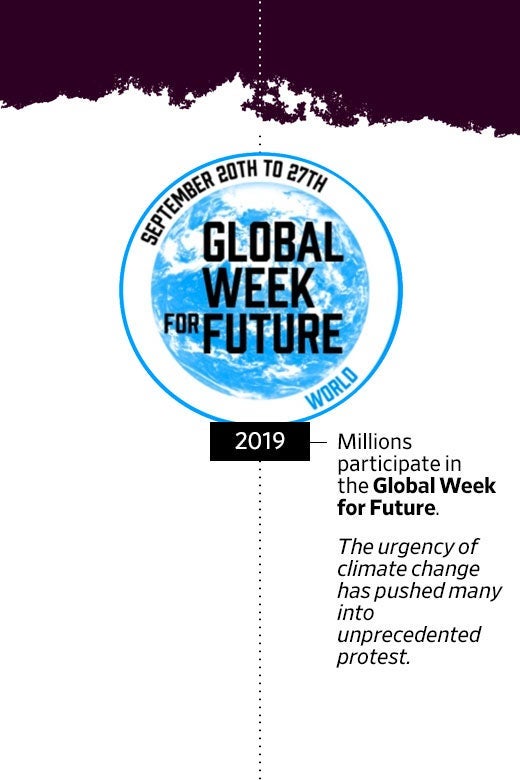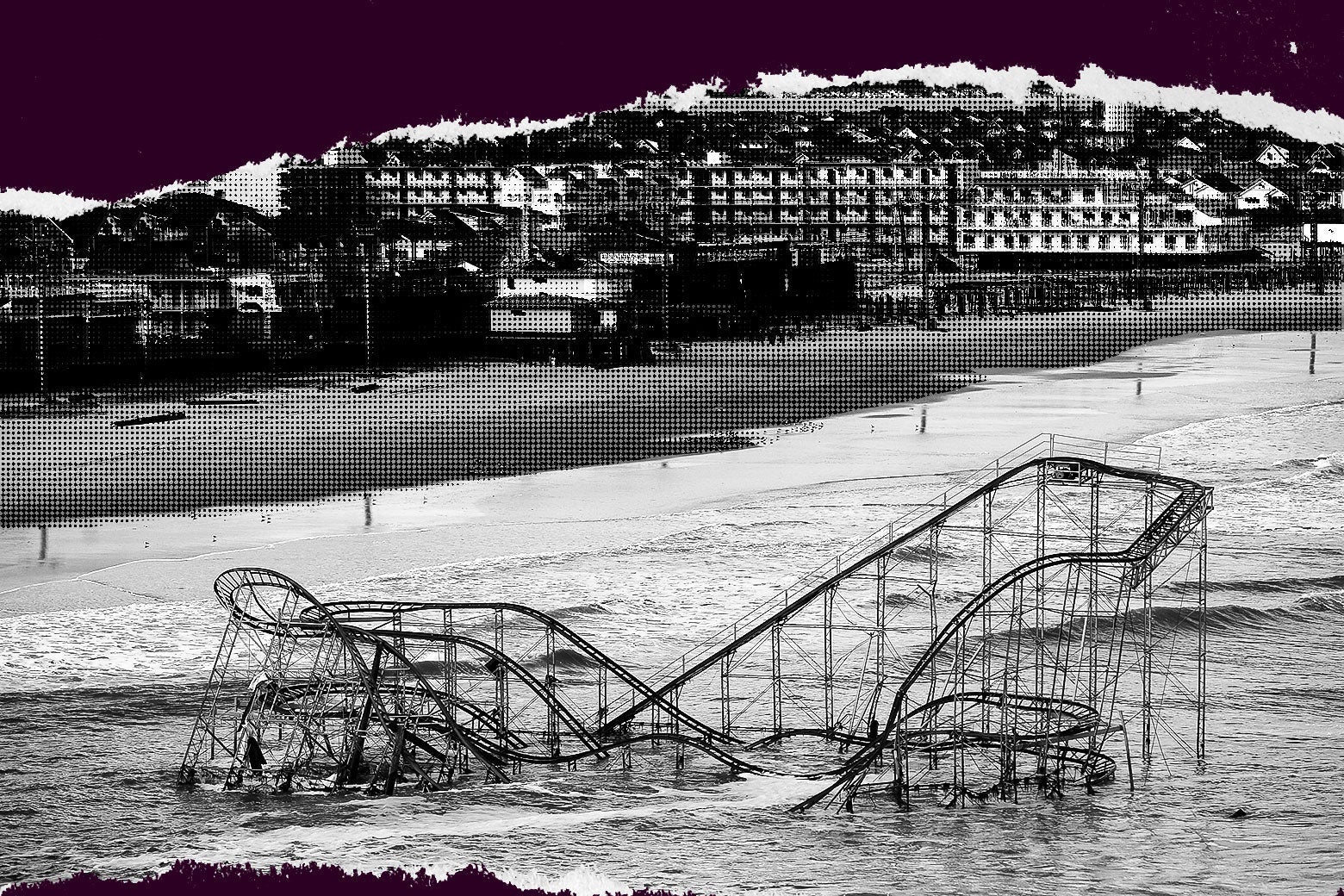Read the rest of Slate’s coverage of the end of the decade.
Stephanie Herring has been a climate scientist for the National Oceanic and Atmospheric Administration since 2009. Even back when she first started at the job, she remembers a pattern playing out every time an extreme weather event occurred. “People would start calling and ask, ‘Did climate change play a role in this?’ And we would answer, ‘We can’t tell you that; there’s no science to tell us whether climate change contributed to this specific event.’ ”
Soon, though, NOAA researchers started wondering if maybe there could be a way to explain climate change’s role in particular cases. The relatively new field of attribution science sought to do exactly that. In a 2004 paper published in Nature, widely regarded as the first attribution science paper, three British researchers modeled how much human activities increased the likelihood for the record-setting summer 2003 heat wave in Europe. The underlying concept used in this first study and subsequent ones is similar to the way we understand risk in public health: Just as medical researchers can study how smoking cigarettes changes people’s risk of lung cancer by comparing data from smokers and nonsmokers, attribution scientists compare events on our planet with those on a hypothetical “Planet B,” one that is untouched by greenhouse gas emissions.

Modeling this hypothetical planet takes a lot of computing power, but over the past decade, better technology has allowed for a boom in the field. “Modeling used to be in the realm of fancy labs at fancy institutions that could afford high-performing computing on-site,” says Herring. Researchers no longer need special banks of computers to run most computations; some projections of the hypothetical, climate-unchanged Planet B can even run on laptops.
Early in the decade, NOAA scientists started wondering how they could leverage these more widely accessible modeling tools to answer some of the public’s questions about climate change’s role in extreme weather. In 2011, NOAA scientist Thomas Peterson, Herring, and a few other colleagues sent a few emails to climate change researchers asking if they’d be interested in putting together a few analyses. Nine people said yes.
The result was a “special supplement” to the Bulletin of the American Meteorological Society’s journal. The researchers concluded that human-caused climate change played a role in five of the six extreme weather events they analyzed: It increased the odds that the winter of 2010–11 was the coldest of the past 100 years in the U.K., and posited that extreme heat events like the 2011 Texas drought were roughly more than 20 times more likely than they were four or five decades ago. This addendum was stapled to the back of the society’s annual “State of the Climate” report—not exactly a sexy, front-and-center feature. At a press conference for the ever-popular State of the Climate report’s release, Herring briefly presented on the attribution science supplement and then sat down in the back of the room with her laptop, thinking she’d use the media Q&A session to catch up on email. She was surprised when the first question from the media was for her—and they kept coming. “The editors were blown away by the level of interest,” she says, and the “Explaining Extreme Events” report has been published by BAMS every year since. Its results routinely make the news: National Geographic highlighted the 2013 report, which connected a rash of heat waves worldwide to climate change. In 2017, the Washington Post covered the entirety of the 2017 report, which included analysis of a marine heat wave that “would have been ‘virtually impossible’ without human influence.”
These analyses convert something both scientists and concerned citizens have long broadly understood about climate change into much more tangible and specific facts. Before, Herring and other climate researchers simply didn’t have the data to draw conclusions about any links between climate change and individual weather events, but armed with these new analyses, researchers can put a number on how much the odds of an extreme event have changed over time. Climate change has loaded the dice. The burgeoning field of attribution science has given researchers the evidence to corroborate that. And the public seems to increasingly get it—this decade, particularly the past year or so, has been marked by increased awareness and alarmism about climate change and the effect it is already having on our lives.

The new science is not without controversy. The past decade has also seen new attribution science methods that illuminate how climate change makes extreme events worse, rather than just measuring the extent to which climate change played a role in their occurrence. In addition to the original method, called the “probabilistic” or “risk-based” approach, some researchers are now also using a method they call the “storyline” approach. Instead of just investigating whether climate change made an extreme event, like a flood, more likely to happen, the storyline method also looks at events that would’ve happened regardless and investigates how much worse climate change made that storm.
Within the field, the storyline approach has been hotly debated; some researchers, including the scientists who published the first attribution science paper, were concerned that the approach’s assumptions could lead to overblown or misleading results. But the approach’s supporters point out that a risk-based approach alone could underestimate real effects of climate change. Consider the different results the two approaches can yield: Analyses of Boulder, Colorado’s 2013 floods using the classic approach found that climate change did not increase the odds of the floods. The storyline approach concluded that climate change made the floods worse by producing 30 percent more rain. “Storyline people made a good case that, actually, understating an effect and understating whether or not climate change is making a difference is, in itself, a dangerous thing to do,” says Elisabeth Lloyd, who studies the history and philosophy of science at Indiana University.

Scientists are trained to be extremely conservative in reporting their results. Statistical methods typically favor false negatives—not finding an effect when it actually does exist—over false positives, which would find an effect where there is none. But when it comes to climate change, Lloyd argues, there may be more harm in being too conservative with standards of evidence. “It has been argued by risk-based approach supporters that the storyline folks are in danger of overestimating an effect and wasting our adaptation funds,” Lloyd said. “But I have yet to see a single dollar that has been wasted. We’re not spending too much preparing for climate change.”
Attribution science findings have already influenced policy and planning, if only obliquely. In a working paper on the law and science of climate change attribution, Columbia law professors write that attribution science papers have served as “a framing mechanism for international negotiations,” like the ones that underlay the Paris Agreement, and have helped policymakers, like those working with the Intergovernmental Panel on Climate Change, assess the long-term impacts and risks of climate change. There’s power in knowing. “I’m a full-disclosure kind of person. We’re in a more powerful situation with regards to our choices about the future when we do have all the cards in the deck,” says Lloyd.
Lloyd says that the more evidence we can gather, the better. “Because the science has advanced, we now understand things much better than before,” she says. Herring said she’s been surprised by how much attribution science has shown us about climate change’s rapid progression. She and other researchers were always careful to stress that natural variability played a role in every case. “Someday, sure, if we keep on this track, the effects of climate change will become so large that we’ll start to see events that could not have happened in a world without climate change,” she would tell people, back in 2011 and 2012. But that “someday” came quickly. Within the past few years, there have been events—like a 2017 marine heat wave off the coast of Australia or Japan’s deadly 2018 heat wave—that are now almost entirely attributable to human-caused climate change. “I was surprised by that,” said Herring. “It was a sudden shift. The future is here. It’s today.”
Attribution science’s rapid rise is shaping more than the public’s understanding. It’s also shaping policy and litigation attempting to deal with climate change. Building on scientists’ work, lawyers representing concerned citizens, cities, and states have used the specificity provided by attribution science to file lawsuits over damage caused by climate change. In the U.S., city governments from New York City to Los Angeles have moved to sue oil behemoths like BP and Exxon Mobil for climate damages from extreme weather events like Hurricane Sandy and the Santa Rosa fires. There’s international litigation, too: Peruvians are suing a German energy company that they say should be held responsible for the half of 1 percent of emissions that has contributed to the glacial melt that threatens to flood their village. It may be years until these cases are settled. But they set an important precedent: As a society, we now have the data to show exactly how climate change is hurting us, which might mean we can hold companies accountable for causing it.
